Friday, March 27, 2015
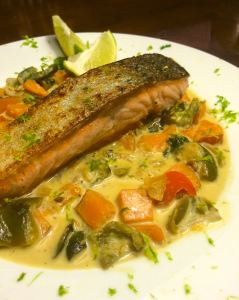 In some Christian traditions, many people consume fish on Fridays during the Lenten season.
In some Christian traditions, many people consume fish on Fridays during the Lenten season.
Other people eat seafood just because it’s delicious.
Whatever the day, whatever the season, today’s recipe brings together perfectly cooked fish in a spicy-sweet green curry sauce with chunks of tender sweet potato and crunchy peppers for a meal that’s special enough for a dinner party but quick enough for a weeknight. If you love the flavors of Southeast Asia, this dish is definitely for you. I created it a few months back and it’s one of my favorites. In fact, I’d go so far as to say that it’s one of the best dishes I’ve ever made. (!!!)
And if you are one of those people who consume seafood on Fridays during the lent, why not try this recipe to spice things up a bit?
Salmon Green Curry
Ingredients
- 2 pieces salmon, seasoned with salt and pepper
- 1 large sweet potato, diced (keep skin on)
- 2 cups of water + 1 teaspoon salt (to boil potatoes)
- 3 tablespoons peanut oil, separated
- 1 medium onion, chopped
- 1 poblano pepper, chopped
- 1/2 red pepper, chopped
- 1/2 teaspoon salt
- 1/4 teaspoon white pepper (or black)
- 2 cloves garlic, minced
- 1 teaspoon ginger, minced
- 1 teaspoon lemongrass, minced
- 1/3 cup green curry paste
- 2 tablespoons beer (or rice wine)
- 1 15 ounce can coconut milk (approximately 2 cups)
- 1 1/2 cups sweet potato “stock” (or whatever you need to complete the sauce)
- 1 teaspoon fish sauce
- 1 1/2 teaspoons coconut palm sugar
- Juice from 1/2-1 fresh lime
- Lime zest, for garnish
Directions
Cut sweet potato into bite-sized chunks, add to salted water, and bring to a boil. Lower heat and simmer about 7 minutes, until soft and cooked but not mushy.
Sear salmon in 2 tablespoons peanut oil at high heat, about 1-2 minutes each side, until deeply colored and skin is crispy. (More on methods for cooking fish is here.) Remove fish to plate and set aside. Add the remaining 1 tablespoon peanut oil to the pan, heat to medium, then sauté the onions and peppers with salt and pepper until soft, about 5 minutes. Add garlic, ginger, and lemongrass and stir until fragrant, about 45 seconds. Stir in green curry paste and cooked sweet potatoes (not stock) until coated, about 1 minute. Raise heat to high and add beer or rice wine to deglaze pan. (Do note that you can find plenty of high quality curry pastes from the supermarket, but making your own is easy and it’s freezes well—I’ve been using the same batch in my past three curries, and counting…)
Gently stir coconut milk, fish sauce, palm sugar, and lime juice into spiced vegetable mixture, then add the sweet potato “stock” a little at a time to get the taste and viscosity you want. (I usually end up using all of it.) Bring mixture up to boil, then simmer 5 minutes until flavors come together. Taste, and reseason the sauce with salt and white pepper as desired.
Add the salmon back to the mixture, skin side faced up. Continue cooking gently over medium-low heat until fish is medium rare, about 5 minutes.
Serve fish atop the curry mixture, zest with lime if desired, and serve with an additional wedge of lime.
Salmon Science: Notes on Health and Sustainabiity
Salmon has its own unique flavor, which is why a lot of people love it. I sure do. On the nutrition front, it’s loaded in super-healthy omega-3 fatty acids, like other fatty fish. It’s also a protein powerhouse, particularly high in the amino acid tryptophan, and a great source of vitamins D, B12, and B3 and minerals phosphorous and selenium. And despite what you’ve heard about potential contaminants in seafood (which can be an issue), rest assured that the majority of scientists agree that the benefits to health—and in the case of pregnant women, the developing baby—outweigh potential risks. In fact, most people do not consume nearly the amount of seafood recommended for optimal health and disease prevention. (An excellent review of the topic by experts at Harvard School of Public Health is here.)
Yet there are complex issues surrounding how salmon gets to our table that vary by the what (the species), where (the geography), and how (the process). Some Atlantic salmon farmed in circulating systems are okay, for example, while those raised in closed pens are concerning due to the use of chemicals and risk of escape. Both wild caught and farm-raised King Alaskan salmon are currently rated as “best choice” by the Monterey Bay Aquarium Seafood Watch, and many other Pacific species (like pink salmon) are also good choices. Note that changes in regulation, production practices, and natural life cycles impact fish stocks and sustainability, so it’s important to refer to a science-based seafood guide like this one to keep informed.
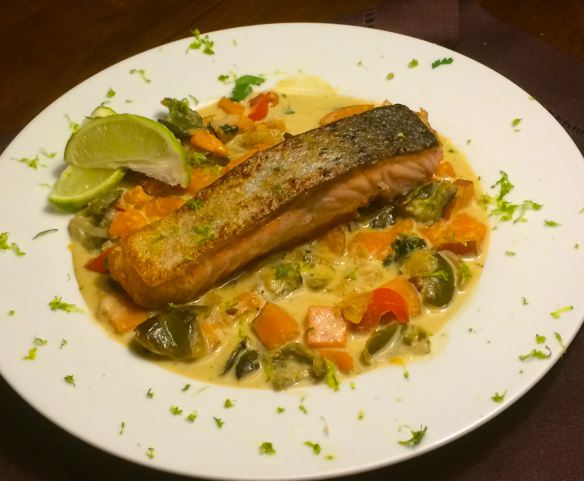
And remember that, as luscious as salmon is—and there are planet-friendly choices available—choosing seafood that is even lower on the food chain is a fantastic idea. This dish would be particularly fabulous with mussels, which is what I plan to make next time. It’s also terrific with a mix of vegetables and rice noodles, a common preparation in our household.
The salmon is sensational in this dish, after all, but the green curry really is the star, if you ask me.

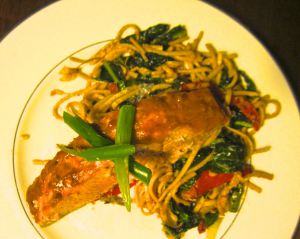
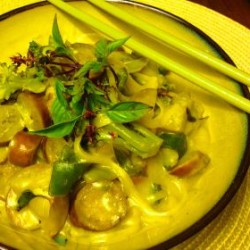
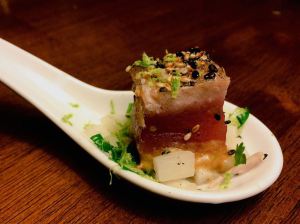
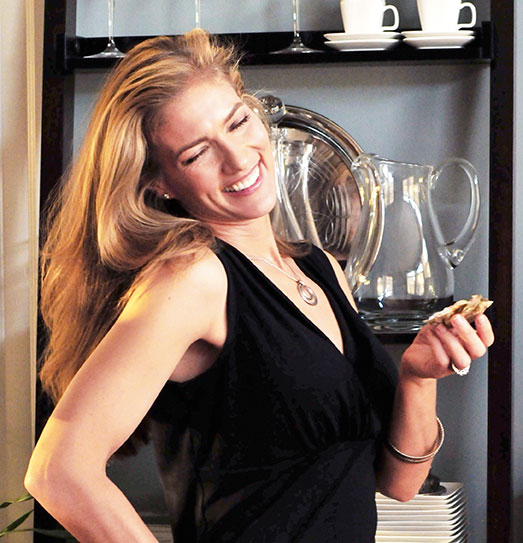
Cool post love fish i blog international cuisine restaurants currently in Holland
Nice food